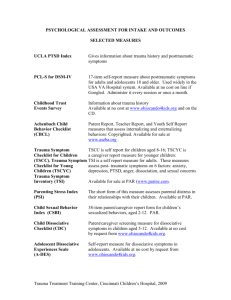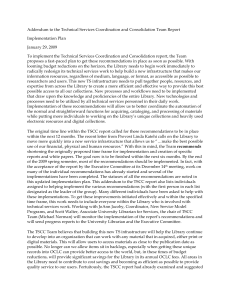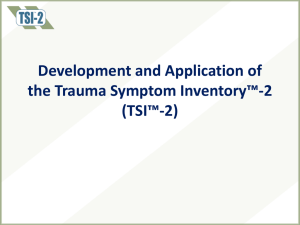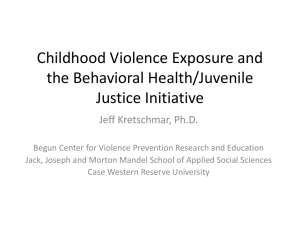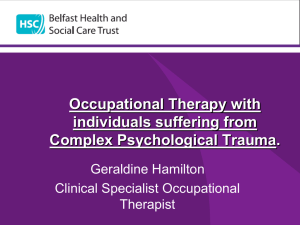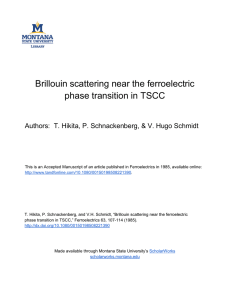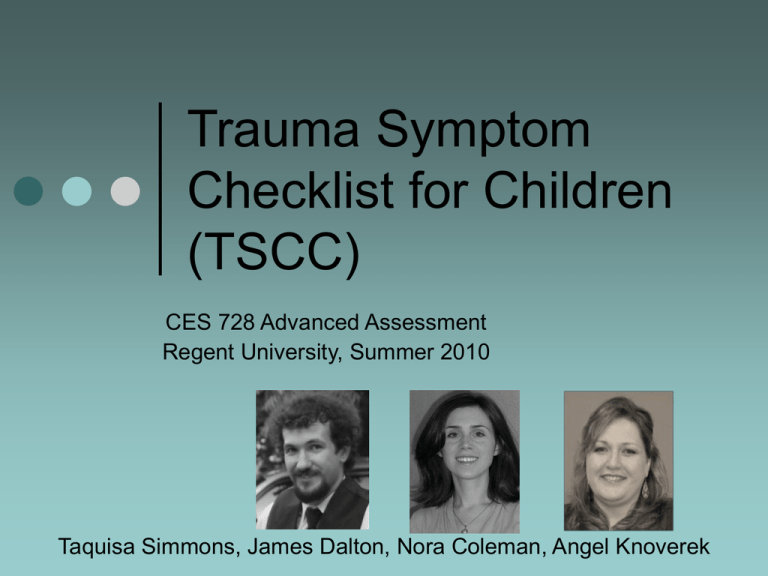
Trauma Symptom
Checklist for Children
(TSCC)
CES 728 Advanced Assessment
Regent University, Summer 2010
Taquisa Simmons, James Dalton, Nora Coleman, Angel Knoverek
Purpose
Self-report measure of posttraumatic
distress and related psychological
symptomatology (Briere, 1996).
Evaluates children who have experienced
traumatic events, including childhood
physical and sexual abuse, victimization by
peers, major losses, the witnessing of
violence done to others, and natural
disasters (Briere, 1996)
Two versions:
TSCC & TSCC-A
Intended Use
Male and female children
Ages 8-16 years; TSI for adults
Normative adjustments for 17 year
olds
Individual or group administration
Recommendations for use
Not designed for use as a diagnostic tool.
Should be used to examine symptom
profiles and symptom course following
trauma. (Ohan, Myers, & Collett, 2002, p.
1408)
Trauma Symptom Checklist for Young
Children (TSCYC) aged from 3 to 12 years
is currently under development (Briere et
al., in press)
Norm Group
o
Derived from large samples (total N>3,000)
of nonclinical children across the United
States (Evans, et al, 1994; Friedrich, 1995;
Singer, et al., 1995)
o
Separate norms and T-scores are available
according to sex and age (8-12 and 13-16)
o
Race not a major predictor of TSCC scores
Psychometric Properties
Reliable for all scales except for
Sexual Concerns
Convergent and predictive validity in
samples of traumatized and
nontraumatized children and
adolescents
Areas of sensitivity: posttraumatic
difficulties, the effects of therapy for
abused children, and the effects of
child protection systems intervention
Strengths
Large norm sample (3,008 children for
TSCC) (LONGSCAN) 828 adults for TSI
(Briere & Elliott, 1997)
TSCC – 10 minutes self-administered; TSI –
20 minutes self-administered
TSI & TSCC are the most widely used selfreport instrument to assess for trauma
related disorders (Elhai, Gray, Kashdan, &
Franklin, 2005)
Does not require parent report as many
measures do for children
Alternate version of each assessment tool
(TSCC-A for children, TSI-A for adults) does
not contain items related to sexual concerns
Weaknesses
Non-clinical norm samples – identifies
possible clinical cases by difference from
the normal population
Non-representative sample – adult sample
is supposed to closely resemble the total
US population, but does not do so
completely
TSI can not accurately distinguish
malingering individuals (Rosen, Sawchuck,
Atkins, Brown, Price, & Lees-Haley, 2006)
Cultural Relevance
Lifetime prevalence of PTSD is 8% in
the US (DSM-IV-TR, 2000)
Childhood trauma can be difficult to
accurately recognize
Use of tools requiring parent report
can often be unusable if parents are
suspected of causing a traumatic
experience
Administration
Test Materials
Professional Manual and the TSCC
Booklet, and the age-and sexappropriate profile form.
Professional Requirements
Administration
Can be given to a group of children.
Environmental considerations.
Scoring
Missing Responses
Calculating Raw Scores
Converting to Standard Scores and
Plotting the TSCC Profile
Interpretation
Normative Comparisons
Interpreting Scores
Validity
Underreponse (UND)
Hyperresponse (HYP)
Clinical Scales
Depression
Anxiety
Anger
Posttraumatic Stress (PTS)
Dissociation
Sexual Concerns
Critical Items
ON VIDEO - Review sample answers,
scores and Example 1 - pages 8-10
Overall Impressions
Briere (1996) has produced a very useful (but
somewhat limited) measure for the psychometric
assessment of traumatic symptoms in children and
adolescents that can be administered, scored, and
interpretred in a relatively efficient and cost-effective
manner, Boyle, G. 1985. The TSCC has been used
extensively in a wide range of studies, and there are
numerous published reports involving data derived
from the instrument (20 such studies have been
reported in the PsycINFO data base since 1999
alone)., Boyle, G., 1985. Compared with other
instruments listed above, the TSCC appears to make a
unique contribution to the measurement of
posttraumatic symptomatology in children and
adolescents.
References
American Psychological Association. (1985). Standards for Educational and
Psychological Testing. Washington, DC: Author.
Briere, J. (1996) Trauma Symptom Checklist for Children: Professional
Manual. Luntz, FL: Psychological Assessment Resources.
Briere, J., Johnson, K., Bissada, A., Damon, L., Crouch, J., Gil, E., Hanson, R., &
Ernst, V. (in press). The Trauma Symptom Checklist for Young Children
(TSCYC): Reliability and association with abuse exposure in a multi-site
study. Child Abuse and Neglect.
Boyle, G. J. (1987). Review of the (1985) “Standards for educational and
psychological testing: AREA, PA and NAME.” Australian Journal of
Psychology, 39, 235-237
Fricker, A., Smith, D.W. (2001) Trauma Specific versus Generic Measurement of
Distress and the Validity of Self-Reported Symptoms in Sexually Abused
Children. Journal of Child sexual Abuse,V10(4),51-66.
Ohan, J.L., Myers, K., & Collett, B.R. (2002). Ten-year review of rating scales, IV:
Scales assessing trauma and its effects. Journal of the American Academy
of Child & Adolescent Psychiatry, 41:12, 1401-1422.

